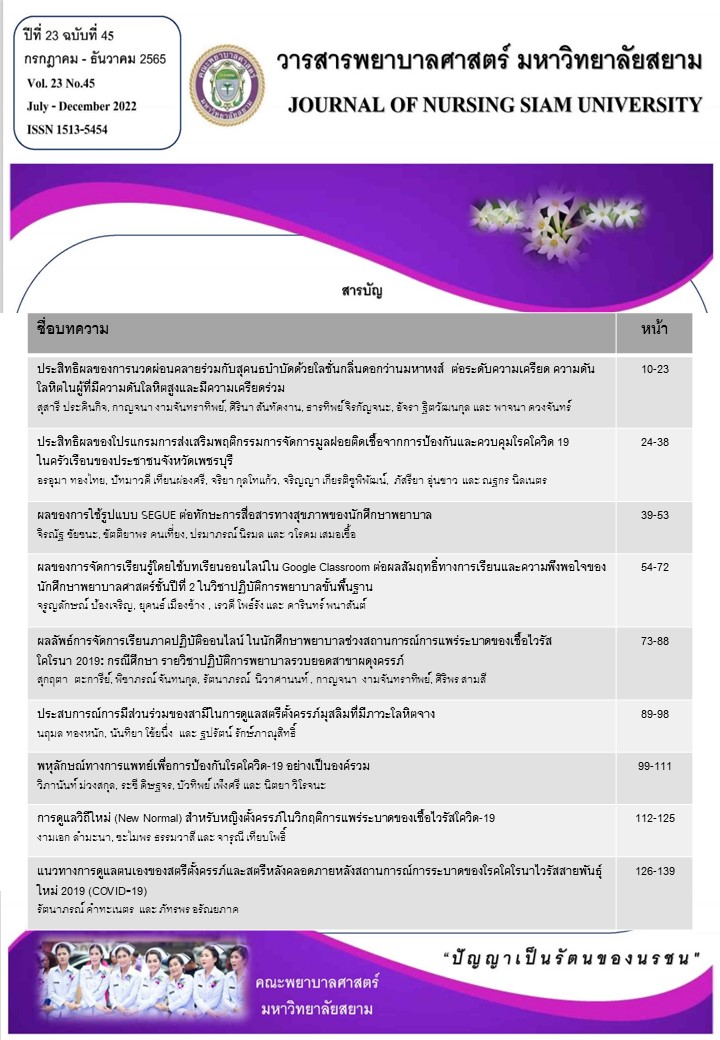Husband's Experience of Participation in Caring for Muslim Pregnant Women with Anemia
Keywords:
Husband's experience, Pregnant woman, AnemiaAbstract
This qualitative research aimed to describe the experiences of husband’s participation in caring for Muslim pregnant women with anemia. Purposive sampling was used to select the informants. Ten respondents were the husband of Muslim pregnant with anemia who had been interviewed using a semi-structured interview. The content analysis was used. Five key findings were 1) meaning of anemia or anemia during pregnancy, 2) perceived of wife’s anemia, 3) perceived of the effects of anemia, 4) husband's involvement in caring for pregnant women with anemia, and 5) recognition of roles and responsibilities in caring for pregnant women according to religious principles. Husband performs the roles and duties prescribed by Islamic principles. Moreover, wives have cooperated in following their husbands according to Islamic principles on the role of women as wives. The results reflect that the religious belief context affects the norm of the behavior of pregnant women.
References
กรมอนามัย. (2565). ภาวะโลหิตจางในหญิงตั้งครรภ์ระดับจังหวัด. เข้าถึงได้จาก http://dashboard.anamai. go.th/dashboard/anemia/changwat? year=2022&kid=27&rg=12
จิตตระการ ศุกร์ดี และ ศิวิไลซ์ วนรัตน์วิจิตร. (2559). ปัจจัย ที่ส่งผลต่อภาวะโลหิตจางจากการขาดธาตุเหล็กของ สตรีตั้งครรภ์ที่รับบริการฝากครรภ์ในโรงพยาบาลส่งเสริมสุขภาพตำบล. วารสารวิจัยทางวิทยาศาสตร์- สุขภาพ, 10(1), 1-7.
บุหลัน ทองกลีบ. (2565) มิติด้านสังคมและสาธารณสุขเพื่อพัฒนาคุณภาพชีวิตของสตรีมุสลิม. The Islamic Foundation. เข้าถึงได้จาก https://www.islammore.com/main/
content.php?page=news&category
=4&id=2663
ดวงกมล ปิ่นเฉลียว. (2560). พยาบาลกับการจัดการภาวะโลหิตจางจากการขาดธาตุเหล็กในหญิงตั้งครรภ์. วารสารพยาบาลตำรวจ, 9(2), 195-102.
ธีราภรณ์ บุณยประภาพันธ์, ศิริวรรณ แสงอินทร์ และ สุพิศ ศิริอรุณรัตน์. (2561). ผลของโปรแกรมการสนับสนุนและให้ความรู้ต่อพฤติกรรมการดูแลตนเองและระดับ ฮีมาโตคริตในหญิงตั้งครรภ์ที่มีภาวะโลหิตจางจากการขาดธาตุเหล็ก. วารสารคณะพยาบาลศาสตร์ มหาวิทยาลัยบูรพา, 26(4): 40-50.
ปิยะพร กองเงิน, วิไลลักษณ์ วงศ์อาษา และ กาญจนา สมบัติศิรินันท์. (2559). ผลของโปรแกรมเสริมสร้างพลังอำนาจแก่สตรีตั้งครรภ์ที่มีภาวะเสี่ยงในการคลอดก่อนกำหนดและสามีต่อพฤติกรรมส่งเสริมสุขภาพ จำนวนของการคลอดก่อนกำหนดและทารกแรกเกิดน้ำหนักน้อย. วารสารสภาการพยาบาล, 31(3), 68-82.
ผาสุก กัลย์จารึก. (2560). ภาวะโลหิตจางในหญิงตั้งครรภ์ที่คลอดในโรงพยาบาลอู่ทอง อำเภออู่ทอง จังหวัดสุพรรณบุรี. วารสารพยาบาลกระทรวงสาธารณสุข, 27(1): 22-32.
มนัสมีน เจะโนะ, รูสอัสซียานี วานิ, ฟารีซา อิหะโละ, สัลมา ชูอ่อน และ เจ๊ะยารีเย๊าะ เจ๊ะโซ๊ะ. (2564). ผลของการให้คำปรึกษาแบบคู่และการสนับสนุนของสามีต่อระดับความเข้มข้นของเลือดในสตรีตั้งครรภ์มุสลิมที่มีภาวะโลหิตจางจากการขาดธาตุเหล็ก. วารสารเครือข่ายวิทยาลัยพยาบาลและการสาธารณสุขภาคใต้, 8(2), 150-163.
ศรัณยา ลาโมะ, สุนันทา ยังวนิชเศรษฐ และ เบญญาภา ธิติมาพงษ์. (2564). ผลของโปรแกรมการส่งเสริมภาวะโภชนาการต่อพฤติกรรมการบริโภคอาหารและยาเสริมธาตุเหล็กและความเข้มข้นของเลือดในหญิงตั้งครรภ์วัยรุ่นที่มีภาวะโลหิตจาง. วารสารพยาบาลกระทรวงสาธารณสุข, 31(1): 224-236.
สุกัญญา ตาแสงสา, ตติรัตน์ เตชะศักดิ์ศรี และ สุพิศ ศิริอรุณรัตน์. (2562). ปัจจัยที่มีอิทธิพลต่อการมีส่วนร่วมในการดูแลหญิงตั้งครรภ์ของสามีวัยรุ่น. วารสารการพยาบาลและการดูแลสุขภาพ, 37(3), 49-58.
สุภางค์ จันทวาณิช. (2554). การวิเคราะห์ข้อมูลในการวิจัยเชิงคุณภาพ (พิมพ์ครั้งที่ 10). กรุงเทพมหานคร: จุฬาลงกรณ์มหาวิทยาลัย.
อัลญาณ์ สมุห์เสนีโต. (2013). อนามัยเจริญพันธุ์ในทัศนะของชาวไทยมุสลิมชายแดนใต้. หน่วยวิจัยอนามัยเจริญพันธุ์ของชาวไทยมุสลิมในพื้นที่สามจังหวัดชายแดนใต้. เข้าถึงได้จาก http://rupattani.myreadyweb.com/article/topic-42801.html#_ftn1
มุหัมมัด บิน อิบรอฮีม อัต-ตุวัยญิรีย์. (2009). สิทธิของสามีและภรรยา. สำนักงานเผยแพร่และสอนอิสลาม อัร-ร็อบวะฮฺ กรุงริยาด. เข้าถึงได้จาก https://islamhouse.com/th/articles/209070/
Cohen K., Capponi S., Nyamukapa M., Baxter J., Crawford, A. & Worly B. (2016). Partner Involvement During Pregnancy and Maternal Health Behaviors. Maternal and child health journal, 20(11), 2291-2298.
Goonewardene, M., Shehata, M., & Hamad, A. (2012). Anemia in pregnancy. Best Practice & Research Clinical Obstetrics and Gynaecology, 26,3-24.
Leangpunsakul, S. (2017). Situation analysis and study on the factors affecting the achievement of problem solving of maternal health care in the 3 southernmost provinces of Thailand. Health Systems Research Institute (HSRI). Cited in 20 Jan 2022, Retrieved from: https://kb.hsri.or.th/dspace/ handle/11228/4273
Piammongkol, S., Chongsuvivatwong, V., Williams, G., Ponpatkul, M. (2006). The Prevalence and determinants of iron deficiency anemia in rural Thai-musalim pregnancy woman in Pattani province. Southeast Asian Journal of Tropical Medicine and Public Health, 37, 553 - 558.
Sandelowski, M. (2000). Focus on research methods. Research in Nursing & Health, 23, 334 - 340.
World Health Organization (WHO). (2012). Guideline: daily iron and folic acid supplementation in pregnant women. Cited in 20 Jan 2022, Retrieved from http://www.ncbi.nlm.nih.gov books/NBK132263/
Wylie, L., Bryce, H. (2008). The Midwives’ guide to key medical conditions: Pregnancy And childbirth. Edinburgh: Churchill Livingstone Elsevier.
Downloads
Published
How to Cite
Issue
Section
License
Copyright (c) 2022 Journal of Nursing, Siam University

This work is licensed under a Creative Commons Attribution-NonCommercial-NoDerivatives 4.0 International License.
Content and information published in the Journal of Nursing, Siam University is the comment and responsibility of the authors.
Articles, information, images, etc. published in the Journal of Nursing. Siam University is the copyright of the Journal of Nursing, Siam University. If any person or entity wants to take all or part of it for publication for any purposes, please reference the Journal of Nursing, Siam University.



